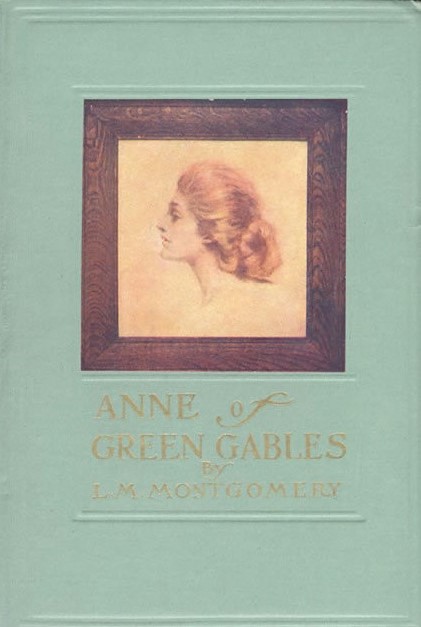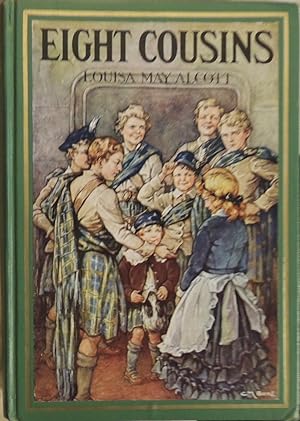 |
| First edition, 1908, initially published in the US -- not Canada --,by L.C. Page & Co. -- of Boston, Massachusetts. Shades of Louisa May Alcott!* |
.... The Anne With An 'e' writers were careful to think out all the aspects of the original text by Canadian author, Lucy Maud Montgomery (1874 - 1942). The series is both as enchanting as an initial read of Montgomery's novel, and appropriately terrible, at least through the first two episodes. The actors are exactly right. The series was conceived and produced holistically, not as separate tasks. This makes it a pitch perfect interpretation in terms of place, time, events and characters.
Some of those who watched this latest translation to screen of Anne of Green Gables on the CBC earlier this spring, or from screeners, have been angry at the changes. However, as I see it, there are no changes from what is in the text. What has changed is that a part of what is contained in the text is not glided over, as Anne herself skates us over, what is contained in the smooth rush of her relentless vocalizing.
This television series gives space to the terrible life that Anne led before being adopted by Prince Edward's Island's Marilla and Matthew. She was orphaned at three months, without family, friends or any other resources. As soon as she was old enough to do anything at all the orphan asylum hired her out (that is the word always used then and there -- asylum). She was treated as badly as any US antebellum little slave girl could have been. Additional torment was meted out by adults and sister orphans alike, because she was the opposite of a pretty little girl, and worse, a homely child who would not keep quiet, and whose intelligence showed itself at every turn. There is ample reason for the netflix series to have Anne identify herself with Jane Eyre, one of the many books she omnivorously has devoured.
One of the many brilliancies of the book is that not being a conventionally pretty little girl with pretty clothes, is that she is mocked and the odd one out for that. But she exhibit neither saintly forgiveness nor a superior ability to rise above the lacks of feature and closet. Instead these lacks are turned inward by herself upon herself, part of both abuse-induced trauma and self-hatred. Anne resembles in no way the cliched YA heroine who hates feminine manners and clothes Instead she, like Jo March longs to be pretty, and like Meg March longs to possess lovely clothes. In other words she is far more real than most YA female protagonists of thirteen.
There are mentions of these extended traumas by Anne, glancing and in passing, in the book's text -- which I first encountered at the same age that Anne is in the book. But the extravagant spillage of Anne's chatter and language, her passion, her instinctive sympathy with Nature, her imagination, keep the reader successfully suspended above these dark, dangerous serpentine, swift currents beneath the bright veneer of her mythos-making that conceals from everyone, most of all herself, that at best, life has nothing to offer her, but bleak privation.
What is brilliant about Montgomery's writing choices is that the closer I was to Anne's character in the first years of re-reading Anne of Green Gables, the less I noticed these dark currents and the slithers of terror in her revelations. I was mesmerized by all the other parts of her that I -- and countless other readers -- saw reflected in Anne of myself: her passion, love of words, her love of school -- I even attended a one-room school like she did! -- history and fiction, her hatred of her own name and yearning for something more Romantic, a pull toward everything that she, at thirteen, labels as "Romantic," her real grief that she isn't pretty and has only practical, sensible and ugly things to wear -- united with knowing what others around her do not from history and books -- that transforms everything around her and her companions into a joyeous, delightful, beautiful, adventurous and -- yah -- Romantic realm. She could always come up with something new and interesting for her friends to play.
Anne suffers from Traumatic Stress Disorder. She copes by language, not with guns, she copes by turning to self-hatred, a form of self-harm -- for not being pretty. She also copes by imagining a different primary identity -- Anne, who also plays at a host of other identities, such as princesses and heroines -- not the abused Ann of beatings, starvation and the constant filth of others that she must clean up. It's not a change from the text, in other words, but an addition of emphasis. In this era it is equally obvious that no one, including herself, knows about this psychological process, in that era prior to WWI.
In that era the condition of orphans everywhere, as in Canada, was scandalously horrific. Changing this was part of the era's Reformist movements objectives. It was anything but uncommon for orphans to be abused physically and emotionally. Death before adolescence or even during adolescence was a common outcome. No one mourned.
Particularly this was the case for the Irish orphans left in Canada from the ship loads of immigrants attempting to flee the Irish famines. The ships arrived with death voraciously aboard in the form of typhoid, cholera and other contagious diseases. Instead of attempting to care for the ill, The coffin ships, as they were called, were anchored off shore -- often without adequate medical attention, food or other supplies provided while the diseases raged aboard. **
I didn't know any of this when first encountering Anne at age twelve, As we see from her name, Ann Shirley, her "poor as church mice parents" were Irish. The Irish were treated even worse in Canada in that era than in the US, and we were awful enough.
As to be expected there are viewers who resent this emphasis on the backstory of Anne of Green Gables. They believe giving it a larger place in the story today is sacrilege to the 'true book'. They want the Anne of their childhood memory, a comic adventure, perpetually sunny Red-Haired Girl, as she's known by myriads of Japanese tourists to Prince Edward Island. We North Americans want the Anne played by Megan Follows*** in the 1985 CBC version, followed by a Disney sequel.**** All of these reject the abused orphan Ann, who, for our sake and her own, has masked herself in swathes of language and dreams -- they want that one to be the only Anne.
However, the text makes clear always there were at least two Anns -- Ann and Anne. Anne was made possible by Marilla and Matthew, who could appreciate this friendless child's only armor and weapons for survival and making her way: her passion, strength of will (which includes her fiery temper), imagination, and intelligence. They saw the abused child as well, and had the sympathy -- Anne's word! -- which is one of the forms of imagination -- Anne's word too! -- to understand that this would indeed make her behave differently from the conventional expectation of a child's behavior. That this could indeed have her 'act out,' as we call it now, but that her acting out was to overtly dramatize, not be 'bad.' They saw that her core was was, in the language of the time, pure and good -- and honest -- and that her innate goodness and her outer Anne could blossom with proper nurturing -- i.e. in the language of the time, the influence of a good Christian home.
Having ordered a boy orphan and gotten Anne instead, Marilla says she must be sent back, but she sees that Matthew is reluctant. What good can a girl do for them with all this farm work as they grow old, Marilla asks. Matthew's response is, "Maybe we should ask what good we can be for her." He well knows his sister's piety is authentic. This is what a Christian should ask in this situation. These two are at least as brilliant creations as Anne herself.
----------------------------
* We may perhaps see some of Montgomery's own imagination at work here, according to this article about Irish orphans. But Canadian novelist, Margaret Atwood, among others, have employed this historical event in her fiction. That abuse and mistreatment of orphan children, and poor children, or just children, was rife in Europe and North America are no myth, however, as the historical and even legal records show here, here and here.
**
Anne has generally been vastly dis-serviced on the screen in the same ways and approaches as has Louisa May Alcott's Little Women. Which reminds me that An Old-Fashioned Girl, Eight Cousins and its sequel, Rose in Bloom, should be purrfect for television series, set as they are within the wealthy Boston mercantile families in the era after the War of Southern Aggression, in what is called the Gilded Age. Need I say I still have all these books, and more, as well as my copy of Anne of Green Gables?
*** Megan Follows most recently has been applauded in the role of Queen Catherine d' Medici, mother of Henri IV, in the historical travesty soap opera, Reign. -- mostly filmed in wintery Canada and Ireland! However, there is a fiction writer part of me, as opposed to the historian, who believes staunchly that Anne with an 'e' would glory in in Reign, and play-act all the roles herself, not least that of the Queen Mother who is -- sometimes and sometimes not -- so cruel to Princess Mary. There are enough princesses and beautiful clothes to even satisfy Anne of Green Gables! Moreover many of the important locations were in wintry Ireland and Canada. What goes round comes round, and Anne would know that.
* * ** Both, but particularly the Disney sequel, were so cloying for this watcher that I gave up on them after a few scenes.



No comments:
Post a Comment